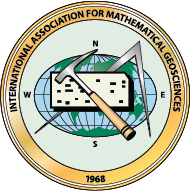Distinguished Lecturer
A. Description
The Distinguished Lecturer prepares a series of lectures preferably on a variety of subjects in the mathematical geosciences to be presented in places where IAMG Annual Meetings are not normally held.
B. Guidelines
The IAMG council voted in 2000 to establish a Distinguished Lecture series and approved a committee charged with implementing the recommendations contained in the report of the IAMG Lecture Series Commission (July 2000).
The purpose of the IAMG Distinguished Lecture series is to demonstrate to the broader geological community the power of mathematical geology to address routine geological interpretation and to deliver this knowledge to audiences in selected parts the world. Therefore, the Lectures Committee is seeking nominations for outstanding individuals who meet the following criteria:
- A demonstrated ability to communicate mathematical concepts to a general geological audience.
- A clear enthusiasm for mathematical geology.
- Recognition for work in their field.
- Established skill in working with individuals and in group discussions on geological problems.
The Distinguished Lecturer must be ready to travel and to perform the following duties:
- Prepare and present a lecture suitable for a general geological audience.
- Prepare and present one or two lectures on a more specialized topic.
- Interact and hold discussions with individuals, both professionals and students, on applications of mathematical geology to local problems of interest.
Letters of nomination should include a curriculum vitae of the nominee and a short statement summarizing the ways in which he or she fulfills the nomination criteria.
Letters should be directed to the Chair of the Distinguished Lecture Series Committee by e-mail to :
Or by regular mail to :
Christien Thiart
Department of Statistical Sciences University of Cape Town
Private Bag Rondebogch 7700
South Africa
C. Current Distinguished Lecturer (2025) – Jeff Boisvert
Uncertainty is an inherent aspect of decision-making in the earth sciences, particularly in mining, hydrocarbon, and wildfire domains. Whether estimating ore reserves, forecasting hydrocarbon production, or predicting wildfire behavior, uncertainties arise from data limitations, model assumptions, and complex natural processes. However, often there is still a reluctance to fully embrace uncertainty in decision-making frameworks. Why do we hesitate to quantify, incorporate, and communicate uncertainty? What are the consequences of this reluctance? What opportunities are we missing?
D. Upcoming Distinguished Lecturer (2026) – Professor Renguang Zuo
Professor Renguang Zuo received his B.S. and Ph.D. degrees from the China University of Geosciences (CUG), Wuhan, China, in 2004 and 2009, respectively. He is currently a full professor at the State Key Laboratory of Geological Processes and Mineral Resources, CUG. In 2014, he was a senior visiting fellow at the James Cook University, Australia.
His research focuses on big data analytics and machine learning-based mineral prospectivity mapping and geochemical anomalies identification. Dr. Zuo has published over 160 peer-reviewed journal papers, 6 books, and book chapters. He has served as the Gust Editor for 8 special issues in international high-quality journals. His publications have amassed over 9,000 citations (Google scholar) across a range of esteemed international journals. In 2023, Dr. Zuo was awarded the Gold Medal, which is the highest award by the Association of Applied Geochemists (AAG). In addition, he was the inaugural recipient of the Kharaka Award by the International Association for GeoChemistry in 2015. Meanwhile, He was recognized as the Elsevier highly cited Chinese scholar and the World’s Top 2% Scientist.
Dr. Zuo is the Vice President of AAG (2025-2026), and was a council of IAMG (2020-2024). He has received fellowships from AAG, Society of Economic Geologists, and Geological Society of London. He has been heavily involved in the editorial boards of many SCI-indexed journals, including Journal of Geochemical Exploration, Geochemistry: Exploration, Environment, Analysis, Computers & Geosciences, Natural Resources Research, Ore Geology Reviews, and Journal of Earth Science.
E-mails: zrguang@cug.edu.cn; zrguang1981@126.com
Googel scholar: https://scholar.google.com/citations?hl=zh-CN&user=8zvKIyAAAAAJ
Lecture 1: Data-knowledge dual-driven mineral prospectivity mapping
Mineral prospectivity mapping (MPM), as a computer-based approach to delineate target areas for a specific type of mineral deposits. MPM typically comprises knowledge-driven and data-driven models. Knowledge-driven MPM relies on expert knowledge, which is based on causal relationships but is not readily adaptable to dynamic changes. Data-driven MPM is capable of identifying underlying data patterns but involves poorly interpretable decision logic. This lecture will focus on the state-of-art big data analytics and AI in MPM to devise a data-knowledge dual-driven model coupling AI with a mineral systems approach to MPM.
Lecture 2: Big data analytics and AI-driven geochemical mapping
Geochemical mapping plays a crucial role in mineral exploration and environmental monitoring by providing insights into geological events and processes such as mineralization and environmental pollution. With the advent of the big data era, how to apply big data analytics and AI to mine geochemical exploration or environmental data from a variety of geological and environmental settings to extract subtle and complex geochemical anomalies associated with mineralization or pollution has become even more challenging. This lecture will focus on the state-of-art big data analytics and AI in geochemical mapping and document successful case studies.
